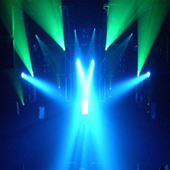Important Vocabulary – Terms used for the Module:
1. Available Light:
Naturally existing light found on location.
2. Background Lights:
The background lights also called ‘specials’ in theatre primarily serves the function of highlighting an important object(s) in the background. Properly designed background light greatly aids to suggest three- dimensionality in a frame.
3. Back Light:
The back light is the third source of illumination in the basic lighting triangle and serves the purpose of separating the subject from the background.
4. Baselight:
The camera’s need a minimum level of light intensity to deliver acceptable video footage i.e. without objectionable video noise.
5. Basic Lighting Triangle:
Basic lighting triangle or “triangular” lighting engages all three source of illumination i.e. key, back and fill light in the ratio of 1:1:1/2 to properly and artistically illuminate a subject.
6. Bounce- Lighting:
A lighting technique in which the instruments are aimed at a white ceiling or walls rather than directly at the subject. The light reflected of these surfaces provides a soft, highly diffused effect.
7. Broad:
A rectangular, open front fills.
8. CTB (Color Temperature Blue):
A color correction gel responsible for converting tungsten light of 3200K to ‘daylight’ color.
9. Color Temperature:
A light source’s relative position along the spectrum of visible light, measured in degrees on the Kelvin scale.
10. Cucalorus (cookie):
A patterned piece of metal, wood or cardboard placed in front of a Fresnel to project the pattern on a wall or other surface: also a patterned metal insert placed inside and behind the lens of an ellipsoidal light used for the same purpose.
11. Cyc Lights:
Broads used to illuminate, and often to colorize, a cyclorama.
12. ENG:
Electronic news gathering.
13. EFP:
Electronic field production.
14. Ellipsoidal Light:
A spotlight creating the narrowest, most clearly shaped and intense beam of light of any instrument used in TV production.
15. Fill Light:
In the lighting triangle, the light responsible for softening shadows made by the key light.
16. Fill Lights(fills):
Sometimes also known as a ‘flood’ are lighting instruments that provides diffused light than spots and are tasked with providing fill and base light plus some background and side lighting.
17. Flood:
Adjusting a lighting instrument such as a Fresnel spotlight to project a broader, more diffused beam of light. Also known as “spread”.
18. Focusing:
Either narrowing or widening the beam of light an instrument emits.
19. Foot Candle (f. c):
The intensity of light falling on a surface placed 1 foot away from a point light source of 1 candle power.
20. Foot Lambert:
The measuring unit for reflected light. Reflected light is the product of incident light falling on an object and the object’s reflectance. The Caucasian face with a typical reflectance of .36 reflects 36 foot lamberts when illuminated with 100 foot candles of incident light(100 f.c. times .36=36 foot lamberts).
21. Fresnel:
An adjustable focus spotlight with a unique glass lens, consisting of a series of concentric circles.
22. Halogen-Metal-Iodide(HMI) Light:
Similar in design and intent to a Fresnel ,HMI lights operate at a color temperature of 5,600 deg.K, compared to a Quartz lamps 3,200 deg.K.
23. Key Light:
The main source of illumination in the lighting triangle.
24. Kicker Light:
A type of back light striking the subject from a low angle. Kickers provide subject with a halo effect.
25. Light Intensity:
The level of brightness provided by a light source.
26. Light Meter:
A photosensitive device that measures light intensity.
27. Lighting console:
A device used to switch lights on and off and/or control the intensities of one or more lighting instruments in a studio. Also called a “board”.
28. Lighting Ratios:
The relative intensities of the key, back and fill lights in the lighting triangle.
29. Lighting Umbrella:
A lighting accessory used to diffuse the harsh quality of spotlights, allowing them to simulate the effect of softlights.
30. Motivated Light Source:
The logical direction in the shot from which the key light should come.
31. Neutral Density (ND) Filter:
A frequently used filter that reduces the intensity of light reaching the camera’s image sensing device(s) without effecting color values.
32. Quartz Lamp:
The artificial incandescent light source used most often in television production. The light features a tungsten filament that glows in an iodide (also known as halogen) gas. The “glass” envelope is made of quartz, from which the lamp gets its name. Also called “tungsten-halogen” or “quartz-iodide” lamps.
33. Reflected Light:
Light that bounces off the subject rather than light striking the subject directly.
34. Set Light:
Fill lights used to provide sufficient baselight in a scene to avoid video noise and flatly illuminate all relevant portions of the set.
35. Spotlights (Spots):
Lighting instruments with beams narrowly focused; used specially for key, back and background lighting.
36. Video Noise:
“Grain or “snow visible in the picture, especially the darker areas. Video noise results due to inadequate base light levels.


